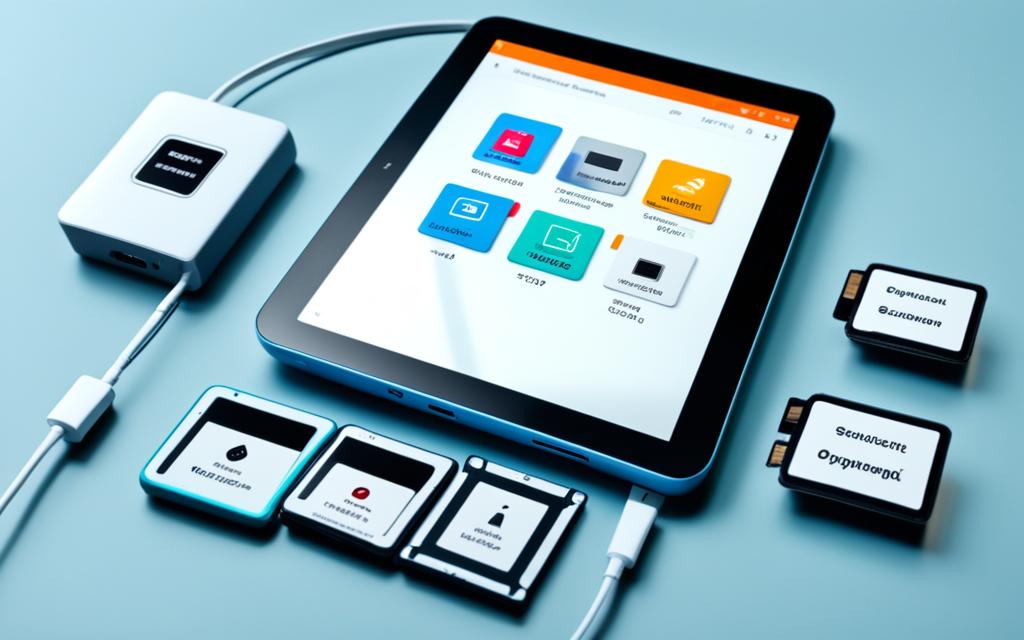Tablet Storage Expansion Options and Solutions
Are you running out of storage space on your tablet? If so, don’t worry! There are plenty of options available to expand the storage capacity and increase iPad storage. Whether you need extra space for apps, files, or media, external storage devices provide the perfect solution. By utilizing adapters and external hard drives, you can optimize performance and ensure that your tablet has ample storage for all your needs.
With the right storage solutions, you can easily and effectively expand the storage on your tablet. External drives offer a convenient way to add extra storage. For example, LAVA’s Charge-Plus adapter allows you to connect an external hard drive or USB memory stick to your tablet. By simply attaching the drive to the adapter’s USB-A port and connecting it to your tablet via a USB-C to USB-C cable, you can access and transfer files with ease. This solution even provides simultaneous charging and data transfer, making it a convenient and efficient option.
Another popular option for tablet storage expansion is cloud storage. Services like iCloud Drive, Google Drive, and Dropbox offer secure online storage for your documents, photos, and videos. By storing your files in the cloud, you can free up valuable space on your tablet while still having access to all your data from anywhere with an internet connection. This is particularly useful for media-heavy files such as photos and videos that can take up a significant amount of storage space on your tablet.
In addition to external storage options, it’s also important to maximize the use of internal storage on your iPad. By deleting unused apps, clearing browser caches, and managing your media collections, you can free up valuable storage space and ensure that your iPad has enough room for critical apps and files.
With the introduction of iPadOS, optimizing storage on iPads has become even easier. The Files app and compatibility with external drives and USB-based flash drives provide more flexibility for managing and expanding storage on your iPad. You can organize your files, transfer data to external drives, and maximize your iPad’s storage capacity with ease.
In conclusion, tablet storage expansion is crucial for users who require additional storage on their tablets. By utilizing external drives, cloud storage, and optimizing internal storage, you can effectively increase your tablet’s storage capacity. Whether you choose to connect an external hard drive or use cloud storage services, there are various solutions available to meet your specific storage needs. With the right strategies in place, you can ensure optimal storage and performance on your tablet.
Using External Drives with Tablets
One effective option for tablet storage expansion is using external drives. External drives provide an easy and convenient way to add extra storage to your tablet, allowing you to store more files, apps, and media without worrying about running out of space.
Connect and Expand
For example, LAVA’s Charge-Plus adapter allows users to connect an external hard drive or USB memory stick to their tablet. With this adapter, you can expand your tablet’s storage capacity and enjoy the benefits of additional space.
By attaching the drive to the adapter’s USB-A port and connecting it to your tablet via a USB-C to USB-C cable, you can easily access and transfer files between your tablet and the external drive.
Not only does this option provide expanded storage capabilities, but it also offers simultaneous charging and data transfer. This means you can conveniently charge your tablet while transferring files to and from the external drive.
Convenience and Efficiency
Using external drives with your tablet gives you the freedom to carry and access your files wherever you go. Whether you need to work on important documents, watch movies on the go, or store large multimedia files, external drives provide the storage capacity you need.
With the ability to connect an external hard drive or USB memory stick, you have the flexibility to expand your tablet’s storage and optimize its performance.
With the right external drive and adapter, you can easily connect and expand your tablet storage, making it a versatile tool for work and entertainment.
Cloud Storage for Tablet Storage Expansion
When it comes to expanding tablet storage, cloud storage is a popular and convenient option. Services like iCloud Drive, Google Drive, and Dropbox provide secure online storage solutions for documents, photos, videos, and more. By storing files in the cloud, users can free up precious space on their tablets while still being able to access their data from anywhere with an internet connection.
Cloud storage is particularly beneficial for media-heavy files such as photos and videos, which can consume a significant amount of tablet storage. By uploading these files to the cloud, users can save valuable space on their devices without compromising accessibility and convenience.
One of the most widely used cloud storage platforms is iCloud Drive, specifically designed for Apple devices like iPads. With iCloud Drive, iPad users can seamlessly store and manage their files, ensuring they have ample space for all their important data.
Table: A Comparison of Cloud Storage Services
| Cloud Storage Service | Storage Capacity | Additional Features |
|---|---|---|
| iCloud Drive | 5 GB (free), Up to 2 TB (paid) | Seamless integration with Apple devices, file sharing options, collaboration tools |
| Google Drive | 15 GB (free), Up to 30 TB (paid) | Integration with Google productivity tools (Docs, Sheets, Slides), collaboration features |
| Dropbox | 2 GB (free), Up to 3 TB (paid) | Smart sync, file recovery, advanced sharing options, integration with popular apps |
As shown in the table above, different cloud storage services offer varying storage capacities and additional features. Users can choose the service that best suits their needs and budget.
Cloud storage is a reliable and secure way to expand tablet storage. It not only provides extra space but also ensures data accessibility and flexibility. By leveraging cloud storage services like iCloud Drive, tablet users can optimize their storage capacity and enjoy a seamless storage experience.
Maximizing Internal Storage on iPads
To ensure you have enough space for your critical apps and files, it is essential to maximize the use of internal storage on your iPad. Expanding external storage is effective, but optimizing your device’s internal storage can also free up valuable space. Here are some strategies to help you maximize the storage capacity of your iPad:
- Delete Unused Apps: Start by identifying and removing any apps that you no longer use. These unused apps can take up a significant amount of space on your iPad. Simply press and hold the app icon until it wiggles, then tap the ‘x’ button to delete it. Remember to take note of any data associated with the app that you may want to back up or save.
- Clear Browser Caches: Over time, your web browser accumulates cache files that can eat up storage space. Clearing the cache can help free up valuable storage. To clear the cache on Safari, go to ‘Settings’, then ‘Safari’, and tap ‘Clear History and Website Data’. For other browsers, consult the browser’s settings menu for cache-clearing options.
- Manage Media Collections: Photos, videos, and music files can quickly consume a large portion of your iPad’s storage. Take time to review your media collections and delete any files that are no longer needed. Consider transferring files to cloud storage or an external device to free up space while still retaining access to your media. Additionally, you can enable the ‘Optimize Storage’ feature in the Photos app to automatically store full-resolution photos and videos in iCloud while keeping device-optimized versions on your iPad.
By regularly assessing and optimizing your storage usage, you can ensure that your iPad has enough space for the apps and files that matter most to you. Keep in mind that these storage-clearing activities should be done periodically to maintain an optimal storage capacity on your device.
Benefits of Maximizing Internal Storage:
Maximizing your iPad’s internal storage offers several advantages:
- Improved Performance: When your iPad has ample storage space, it can operate more efficiently, allowing apps to run smoothly and reducing the risk of lag or slowdowns.
- More Available Space: By clearing unnecessary files, you create more room for important documents, media, and apps, ensuring you have plenty of storage for your needs.
- Reduce Reliance on External Storage: While external storage options can provide additional space, optimizing your internal storage allows you to rely less on external devices. This can be particularly beneficial when you’re on the go or have limited access to external storage solutions.
- Streamlined File Management: With more available space, organizing and managing files becomes more straightforward, allowing you to find and access what you need more efficiently.
Maximizing your iPad’s internal storage is a proactive approach to ensure optimal performance and efficient storage usage. By implementing the strategies mentioned above, you can enjoy a clutter-free device with ample space for your essentials.
Storage Optimization Strategies
| Strategy | Description |
|---|---|
| Delete Unused Apps | Identify and remove apps that are no longer needed to free up space. |
| Clear Browser Caches | Remove accumulated cache files from your web browser. |
| Manage Media Collections | Review and delete unnecessary photos, videos, and music files. Consider offloading media to cloud storage or an external device. |
Optimizing iPad Storage with iPadOS
With the introduction of iPadOS, iPad users now have access to enhanced file-management capabilities that allow for more efficient storage optimization. By utilizing features such as the Files app and compatibility with external drives and USB-based flash drives, users can easily manage and expand their iPad’s storage capacity.
The Files app serves as a central hub for file organization, providing users with a user-friendly interface to access and manage their files. It offers seamless integration with various file services, including iCloud Drive, Dropbox, and Google Drive. By utilizing this powerful app, users can efficiently categorize, rename, and delete files, freeing up valuable storage space on their iPads.
One of the standout features of iPadOS is its compatibility with external drives and USB-based flash drives. This allows users to easily transfer files to and from these external storage devices, freeing up internal storage and ensuring that users always have quick access to their files. Whether you need to offload large media files or share documents between multiple devices, the ability to connect an external drive to your iPad provides a convenient and flexible storage solution.
H3: Using the Files app to manage storage
The Files app offers an intuitive and comprehensive storage management experience. With just a few taps, users can:
- Organize files into folders and subfolders
- Move files between different locations
- Rename files and folders
- Delete unnecessary or redundant files
By taking advantage of these file-management capabilities, users can effectively declutter their iPad’s storage and optimize its capacity.
H3: Expanding storage with external drives
With iPadOS, users can connect external drives to their iPads, expanding their storage capacity without sacrificing convenience. External drives can be used for a variety of purposes, including:
- Backing up important files and documents
- Storing large media files, such as videos and high-resolution photos
- Archiving and accessing large datasets or project files
H3: Maximizing storage efficiency
To further optimize iPad storage, there are a few additional strategies that users can employ:
- Offload unused apps: iPadOS allows users to automatically offload unused apps, which removes the app from the device while retaining its data. This frees up valuable space without losing any important information.
- Clear cache and temporary files: Temporary files and browser caches can take up significant storage space over time. Clearing these files regularly can help maximize available storage capacity.
- Utilize cloud storage: iCloud Drive and other cloud storage services provide an additional layer of storage for iPad users. By storing files in the cloud, users can access them from any device with an internet connection, reducing the need for local storage.
By utilizing these strategies and taking advantage of the file-management capabilities offered by iPadOS, users can effectively optimize their iPad’s storage and ensure they have ample space for apps, files, and media.
Conclusion
Tablet storage expansion solutions are essential for users seeking additional space to accommodate apps, files, and media on their devices. By leveraging the use of external drives, cloud storage, and optimizing internal storage, individuals can effectively enhance their tablet’s storage capacity. Whether it involves connecting an external hard drive or capitalizing on cloud storage services, there are a plethora of solutions available to cater to diverse storage requirements. Implementing the appropriate strategies is paramount to ensuring optimal storage and performance on tablets.












